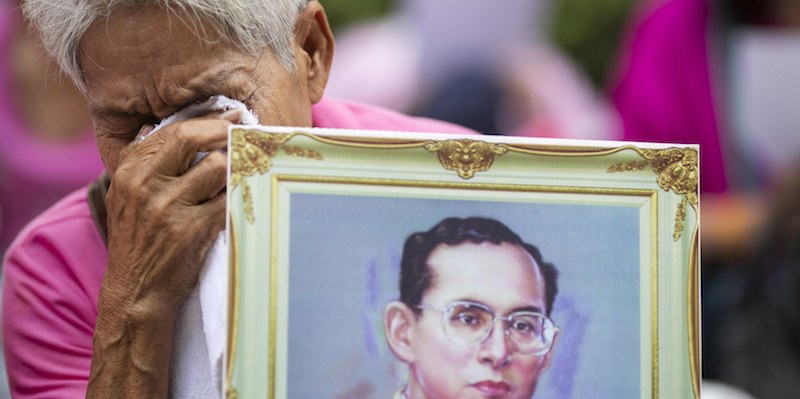The overwhelming majority of Thai seem determined to observe strict mourning for at least thirty days (expiring on November 14th): all dressed in black, black shirts, black pants, black shorts, and black t-shirts. White is also a mourning color, therefore men can wear black pants and white shirts, while women can wear black skirts and white blouses. The general directive is that in the absence of black clothing, tourists must still wear austere colors, tending toward dark shades (nothing gaudy). Tourists are recommended to wear the black crisscrossed ribbon to confirm compliance with mourning traditions. After the thirty days, those who do not want to continue wearing black can return to normal clothing, but they must be austere in color and they must display the black ribbon or armband. It’s likely that the monarchic strata of the population will continue to follow strict mourning for three months, if not twelve. State employees, like teachers, are obligated to wear black for an entire year. It is customary for men to wear black suits with white shirts for formal occasions. Obviously, black dresses are expected for women. The majority of events in the next three months have been cancelled or postponed until the end of January. All monuments and museums are open (except for the royal palace during planned ceremonies).
As far as Bangkok’s nightlife is concerned, it’s business (almost) as usual after a weekend of mourning. But the word is “quietly.” No loud music in bars and nightclubs, women aren’t scantily clad, but “decorously” dressed in black. The external facades need to conform to the highest levels of dignity, so that nothing (excessively) disrespectful shows through to pedestrians. But, on the inside, women continue to dispense traditional services and the bars serve beer and liquor liberally. Closing hours have been moved up by order of the police: from 2 am to twelve-thirty am in Bangkok, and 1 am in Pattaya. Obviously, nightclubs are also opening earlier, at 7 pm instead of 9 pm.
Hundred of thousands of people, even the most poor, are arriving in Bangkok from all over Thailand to pay their respects to the late king. Candle-lit oceanic choirs since the national anthem in the mystic atmosphere of Sanam Luang, the great funerary ceremonial field next to the Grand Palace, where the body of King Rama IX Bhumibhol lies in wait of his cremation, which will ostensibly occur in a year. Life is at a standstill, yet it continues. But tourism is too strong and dynamic a component of the lethargic Thai economy, and state agencies—in particular the Tourist Authority of Thailand—have already mobilized to stop serious repercussions, insisting that “Thailand is open,” and not at all closed during the grief and mourning.




















Lascia un commento